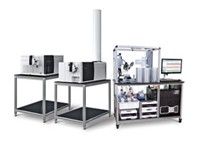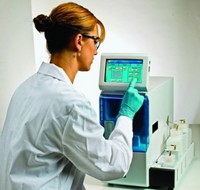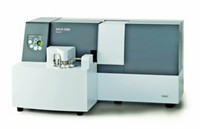Advertisement
Grab your lab coat. Let's get started
Welcome!
Welcome!
Create an account below to get 6 C&EN articles per month, receive newsletters and more - all free.
It seems this is your first time logging in online. Please enter the following information to continue.
As an ACS member you automatically get access to this site. All we need is few more details to create your reading experience.
Not you? Sign in with a different account.
Not you? Sign in with a different account.
ERROR 1
ERROR 1
ERROR 2
ERROR 2
ERROR 2
ERROR 2
ERROR 2
Password and Confirm password must match.
If you have an ACS member number, please enter it here so we can link this account to your membership. (optional)
ERROR 2
ACS values your privacy. By submitting your information, you are gaining access to C&EN and subscribing to our weekly newsletter. We use the information you provide to make your reading experience better, and we will never sell your data to third party members.
Analytical Chemistry
New and Notable at Pittcon
by Stu Borman
April 2, 2012
| A version of this story appeared in
Volume 90, Issue 14
Some introductions of new products at Pittcon do not fall into the traditional categories analyzed each year by C&EN’s four academic Pittcon new-instrument advisers (see page 38 ), and some instruments are noteworthy despite there having been insufficient space to describe them all in the article on our advisers’ suggestions. Descriptions of a potpourri of such instruments are described here for your analytical delectation, based primarily upon information provided about the new instruments by their vendors.
COVER STORY
new and notable at pittcon

Shimadzu Scientific Instruments’ SALD-2300 laser diffraction particle-size analyzer measures particle dimensions in wet or dry samples to ensure product quality in the pharmaceutical, food and beverage, ceramics, and electronics industries. The instrument measures particle sizes from 17 nm to 2.5 mm at intervals of one second or more. Its WingSALD II control software automatically calculates sample refractive indexes, and its measurement-assist function reduces operating errors by allowing users to obtain measurements using consistent conditions and procedures. The SALD-2300 rarely requires adjustment because its omnidirectional shock absorption frame isolates all elements of the optical system from external disruptions, improving instrument stability and reproducibility

Bruker introduced the CryoProbe Prodigy, a sample probe that cost-effectively provides a 300-MHz-equivalent sensitivity boost to existing 400-, 500-, and 600-MHz nuclear magnetic resonance spectrometers. For example, the device makes it possible for a 400-MHz NMR instrument to operate at 700-MHz sensitivity, enabling time-consuming NMR experiments to be performed much faster. CryoProbe Prodigy uses nitrogen-cooled radio-frequency coils and preamplifiers to deliver the sensitivity enhancements for a range of nuclei.

Until now, the smallest nuclear magnetic resonance spectrometer capable of obtaining chemical shift information on nuclei in samples has been the size of a desk and cost about $100,000, according to PicoSpin. The company has now reduced this type of NMR instrument to the size of a shoe box and a cost of about $25,000. The level of miniaturization that made the new PicoSpin-45 possible is based on microcoil NMR research and magnet advances. The 10.5-lb instrument, which is being distributed exclusively by Cole-Parmer, is designed for education, process control, and other applications where size and cost are important. The 45-MHz miniature NMR obtains proton spectra at resolutions exceeding 100 ppb. To obtain spectra, liquid samples of 20 μL or larger are injected into an internal capillary via front-panel fittings. The instrument’s temperaturecontrolled permanent magnet operates without any need for a cryogenic liquid.

Bruker introduced MicroCalix and MicroPix, compact small-angle X-ray scattering (SAXS) systems designed for nanoparticle analysis in biomedical and pharmaceutical research, among other applications. In these instruments, a Bruker microfocus X-ray source and Vantec-1 X-ray detector have been combined with a Kratky Micro series SAXS camera. The systems open up “new fields of applications where either measurement speed or primary beam flux density [is] essential to collect data from weakly scattering materials or solutions,” the company says. The MicroCalix system performs not only SAXS but also microcalorimetry.

ChipCAL from TTP Labtech is a microliter flow calorimeter for enzyme research. The instrument enables researchers to measure enzyme activity more rapidly than with conventional calorimeters. ChipCAL could significantly enhance high-throughput enzyme screening in the biopharma, food, and fermentation industries by analyzing up to 60 samples per day, TTP Labtech says. In operation, enzyme and substrate are passed simultaneously through the instrument’s flow cell. This approach makes it possible to detect thermodynamic changes in sample volumes as small as 15 μL, minimizing the amount of sample needed per analysis. The samples can subsequently be passed through to a waste unit and a new sample loaded without the need for a laborious wash stage.

Beckman Coulter has spun some advanced features into its new line of ultracentrifuges, the Optima X Series, to increase productivity and reduce costs. Optima X Series ultracentrifuges reach speeds as fast as 100,000 rpm but are nevertheless the quietest floor model ultracentrifuges available, according to the company. Remotecontrol capabilities enable the instruments to be operated from personal computers or smartphones, and the centrifuges can send e-mail messages to users if the onboard diagnostics sense problems. Touch-screen displays are large and easy to operate, even with gloves, and include real-time graphing of centrifugation speed and temperature as runs progress. Regenerative braking captures energy generated in rotor slowing and applies it back to a lab’s local circuit, reducing energy costs. The series has two models: the basic XE model and the advanced XPN model. The XPN model adds networking, onboard simulation, and customizable security and tracking to the XE’s functions.

Oxford Instruments launched a benchtop electron magnetic resonance (EMR) system called AffirmoEX. Electron magnetic resonance, also called electron paramagnetic resonance or electron spin resonance, measures unpaired electrons in free radicals, transition-metal complexes, and other species. Oxford designed AffirmoEX for the academic marketplace, where it believes EMR instruments are underutilized owing to the obsolescent design and high cost of previous commercial systems. According to the company, “AffirmoEX is an affordable system occupying minimal bench space. It does not require the large magnets and cooling systems needed by older style systems. It will be offered with a curriculum package for teaching professionals to bring the technique back into laboratories of the 21st century.” Other application areas include the food, transport, and engineering industries.

CEM’s new Mars 6 microwave sample preparation system recognizes vessel types and automatically programs parameters needed for fast, complete digestions of samples for elemental analysis. The unit maintains proper reaction conditions by controlling its 1,800-W dual magnetrons to optimize the microwave energy delivered to specific sample vessels. Its user interface includes a high-resolution color LED touch screen with speakers, and its One Touch Technology software permits users to select among preinstalled methods to choose those appropriate for specific samples.

Waters introduced a new product line of analytical standards and reagents. The aptly named Waters Analytical Standards & Reagents begins with a portfolio of 200 products, and the company plans to add new products to the collection in response to customer demands. The products will be manufactured at a newly built facility in Golden, Colo., and they will be available for purchase online. Waters notes that the standards and reagents will be useful for the proper calibration, control, qualification, and assessment of analytical or preparative liquid chromatography, LC/ mass spectrometry, and supercritical fluid chromatography instruments.

Thermo Fisher Scientific introduced one new and one updated capillary high-pressure ion chromatography system at Pittcon 2012—the Dionex ICS-4000 and -5000. The dual-channel ICS-5000 was first introduced two years ago, but high-pressure capability has now been added, enabling operators to achieve higher efficiency separations. The new ICS-4000 incorporates the ICS-5000’s capillary and new high-pressure features but is a less expensive single-channel instrument suitable for routine analysis. Both systems are compatible with new highly efficient 4-μm particle-size columns and are “reagentfree” systems that use deionized water to electrolytically generate high-purity eluants. Both also support a range of ion chromatography detectors, including conductivity, electrochemical, ultraviolet-visible, and mass spectrometry types as well as the new Dionex QD, a charge detector optimized for weakly dissociated ions such as organic acids, amines, and silicates.

The YSI 2900 advanced biochemistry analyzer, from Xylem Analytics’ YSI brand, has a smaller footprint than the company’s previous analyzers and accommodates a wide range of sample containers, including 96-well plates. It produces results in about 60 seconds for glucose, lactate, ethanol, and other biochemical substances with accuracies comparable to those of high-performance liquid chromatography. The icon-driven user interface has built-in training videos for easy operation, and the system’s built-in sample-handling capabilities eliminate the need for a separate autosampler. Applications include bioprocess monitoring, biofuel production and research, clinical blood chemistry, and food and beverages.

iDisso, from Electrolab of Mumbai, India, is a dissolution tester that eases observation and recording of the dissolving and disintegration process that drug pills undergo in stirred aqueous media. iDisso can record more than 1,000 hours of continuous video of dissolution and disintegration processes and capture still images at preprogrammed intervals, making it possible to study the dissolution of different layers of multilayer drugs. The instrument also includes a blackout option to prevent damage to light-sensitive drugs. Applications include evaluating out-of-specification drugs and optimizing drug formulations.

Princeton Instruments introduced an indium gallium arsenide (InGaAs) camera designed for advanced low-light nearinfrared and shortwave-infrared imaging and spectroscopy. According to the company, the PIoNIR 640 is the first scientific-grade camera to use a deepcooled InGaAs focal plane array for light detection. The camera combines a 640 x 512 array (with peak quantum efficiency greater than 80%) with thermoelectric cooling (down to –90 °C) and low-noise readout electronics to provide unusually high sensitivity for its wavelength range. A gigabit Ethernet data interface enables remote operation. Applications include nanotube fluorescence imaging, semiconductor failure inspection, singlet oxygen imaging, nearIR fluorescence and absorbance measurements, and deep-tissue imaging.

SFC Fluidics’ portable low-pressure liquid chromatography system, the Handy-LC, exemplifies the instrument miniaturization trend evident at Pittcon in recent years. The Handy-LC, about the size of a shoe box, eliminates “the need to stabilize samples and transport them to a laboratory for analysis and purification and will therefore increase efficiency and lower total costs in production and research environments,” according to the company. The system’s ePump provides precise flow rates spanning four orders of magnitude in a pulseless manner. And its QuickConnect connectors enable the system’s modular components and fluid lines to be snapped together easily. Applications include quality assurance of vaccines in resource-constrained environments, in-line quality control of bioprocesses, and biopharmaceutical discovery and development.





Join the conversation
Contact the reporter
Submit a Letter to the Editor for publication
Engage with us on Twitter